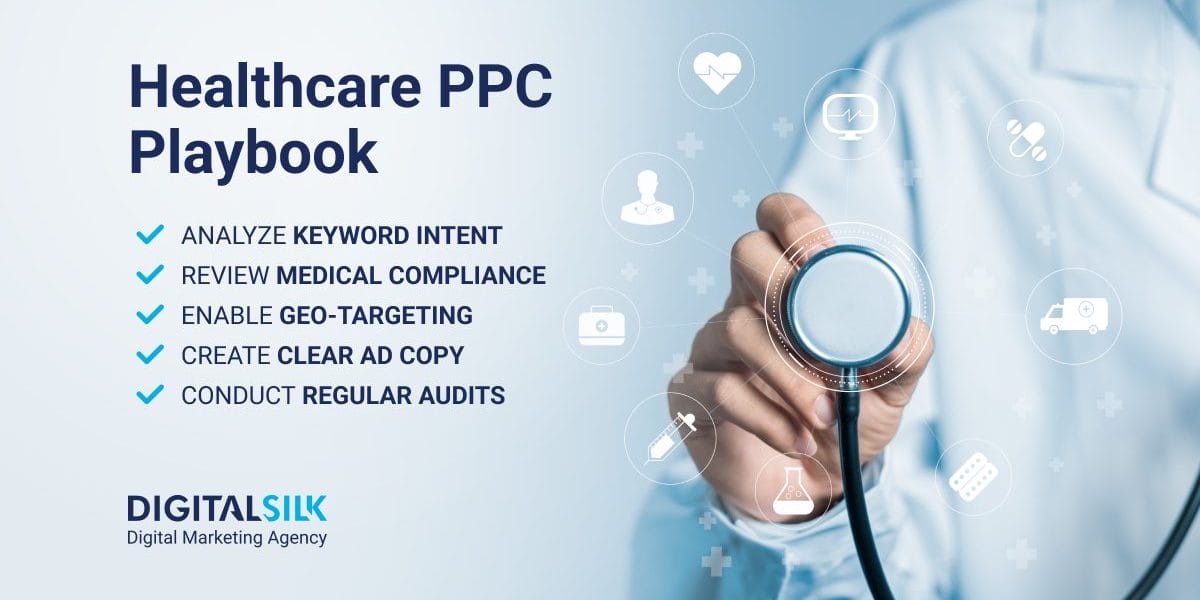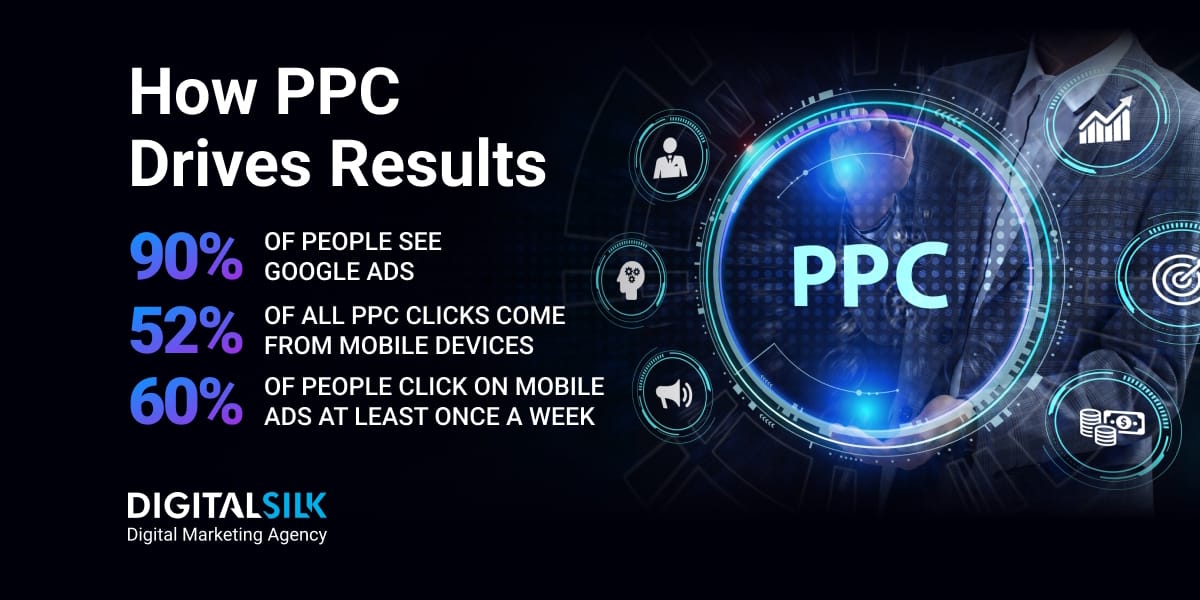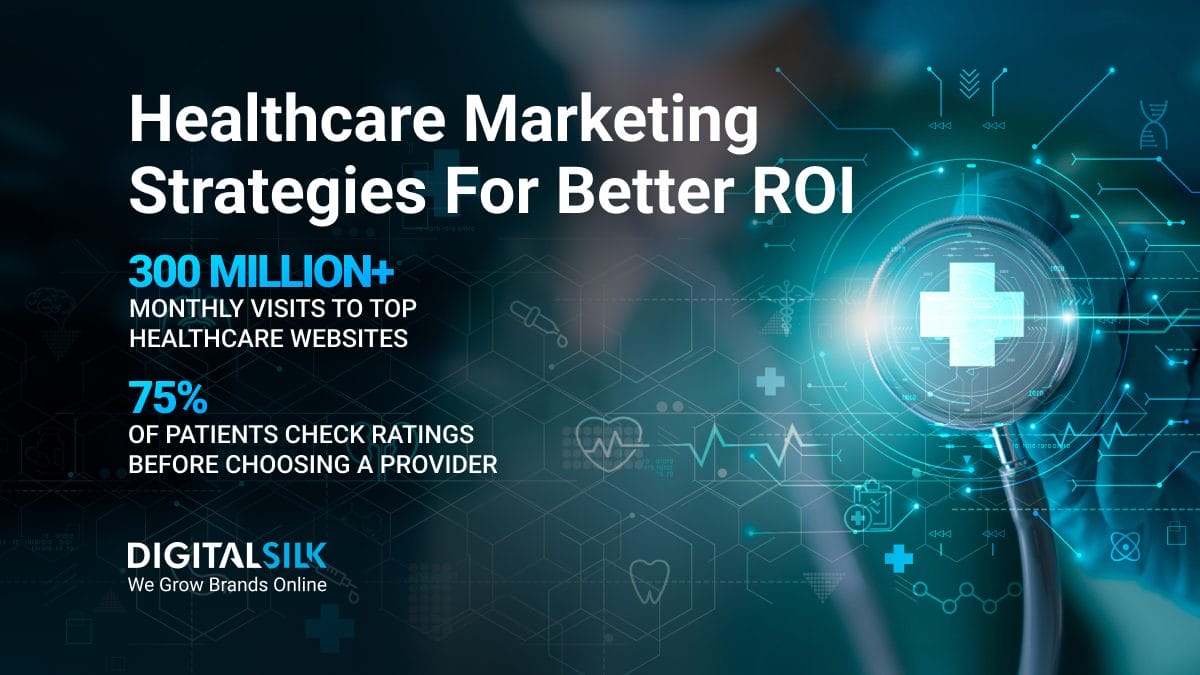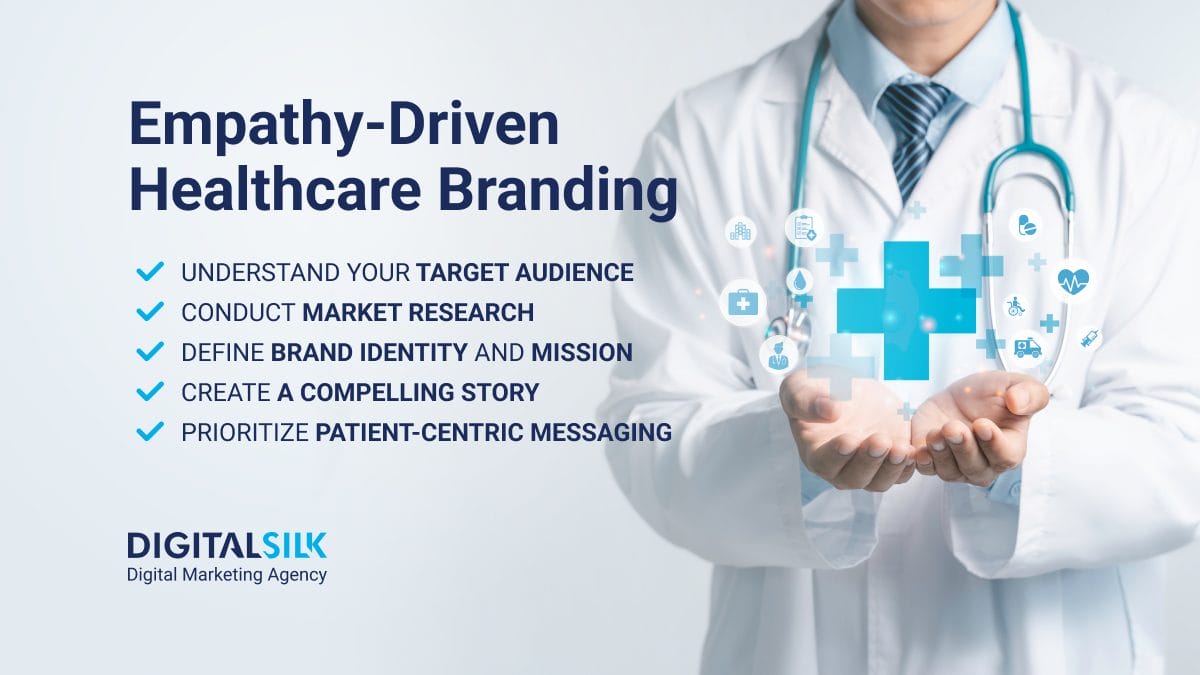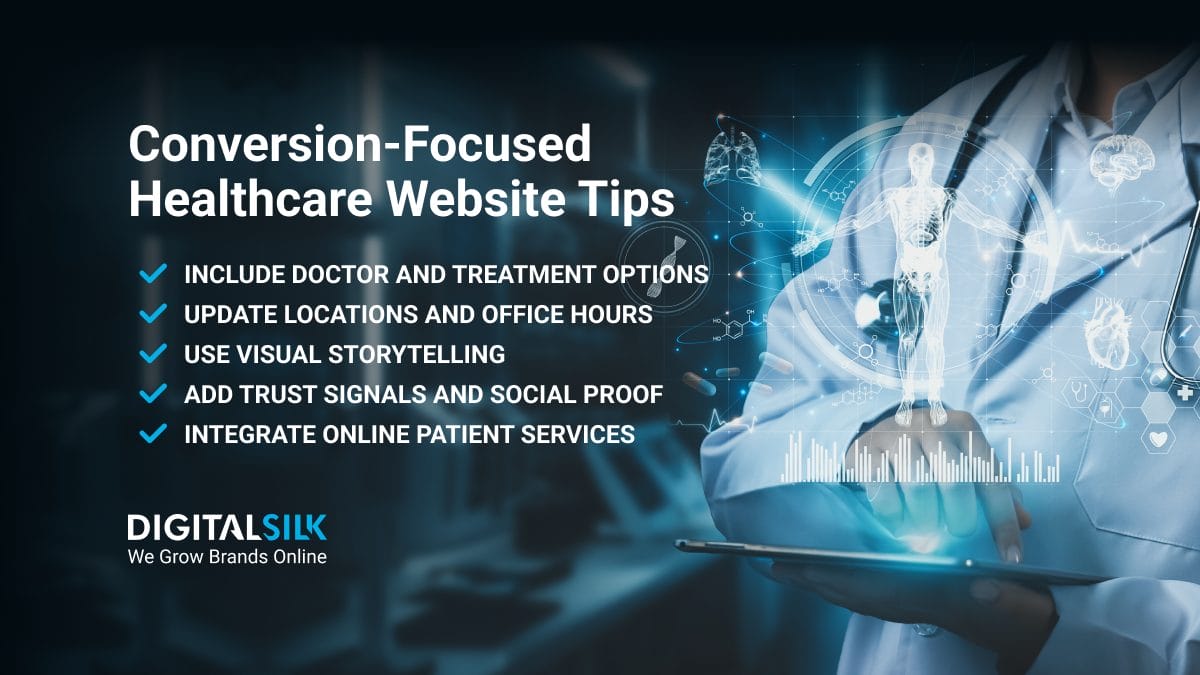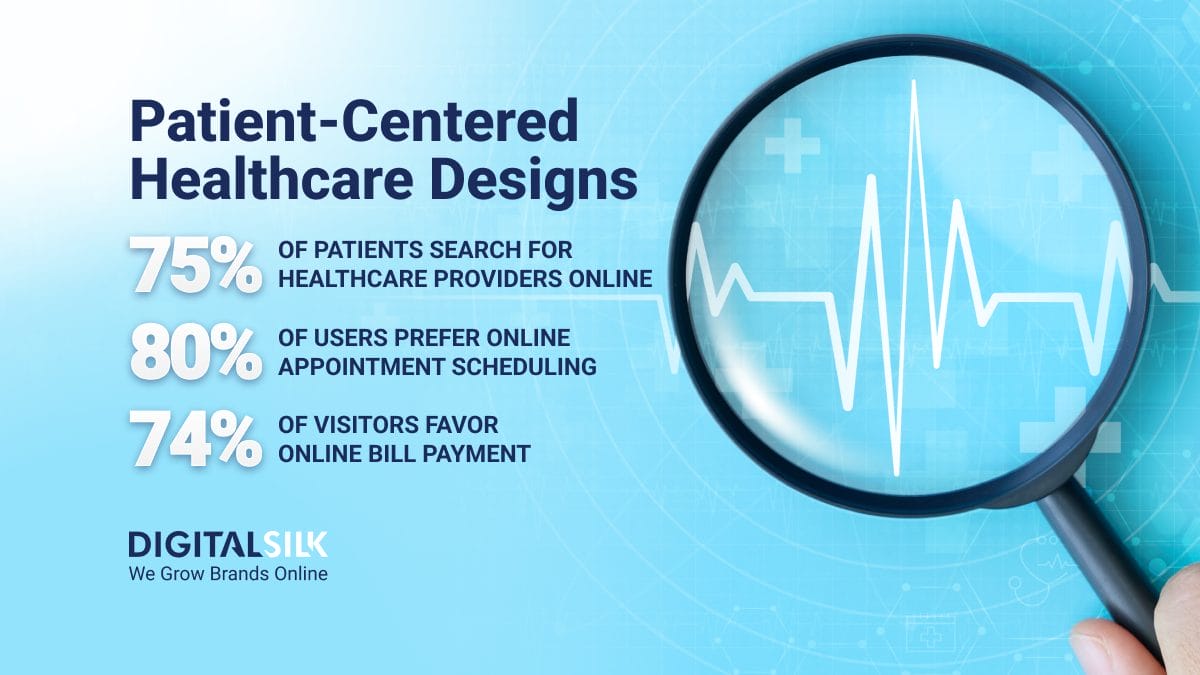Healthcare PPC Strategies: Key Highlights
-
Segmenting boosts relevance: Separate campaigns for patients and professionals improve targeting, messaging and ROI.
-
Intent-driven keywords convert better: Aligning search intent with patient journey stages increases qualified leads.
-
Compliance builds trust: HIPAA-safe ads with clear, honest messaging protect data and enhance credibility.
With healthcare and pharmaceutical digital ad spend set to hit $24.71 billion by 2026, reaching patients online will demand sharper targeting and smarter strategy than ever before.
Strategic Pay-Per-Click (PPC) campaigns drive instant visibility and engagement by focusing on geo-targeting, compelling ad copy and data-driven enhancements.
At Digital Silk, our tailored, HIPAA-compliant PPC campaigns help healthcare providers:
- Lower patient acquisition costs
- Increase booking rates
- Ensure platform and data privacy compliance
- Integrate with Customer Relationship Management (CRM) and Electronic Health Record (EHR) systems for closed-loop reporting
Below, we’ll explore nine proven healthcare PPC strategies to help you capture qualified leads, maximize ad spend and turn your digital advertising into a powerful patient acquisition channel.
1. Segment Campaigns For Patients And Healthcare Professionals (HCPs)
72% of digital advertisers state that achieving efficient growth is their primary goal for PPC campaigns — and segmentation is the key to reaching it.
Rather than taking a one-size-fits-all approach, you’ll achieve significantly better results by dividing your audience into distinct groups with tailored messaging.
Patients and healthcare professionals may research similar topics, but they respond to entirely different messaging, language and value propositions.
To avoid wasted spend and diluted impact, build separate campaigns tailored to each group from the ground up.
As one of the most effective paid search tips for doctors, this approach lets you address both audiences without confusing messaging or wasting budget on mismatched clicks.
Start by developing detailed personas for both audience segments.
For patient-focused campaigns, examine:
- Age, profession and income demographics
- Specific healthcare concerns and symptom patterns
- Insurance coverage and payment preferences
- Geographic location relative to your practice
For HCP-focused campaigns, prioritize:
- Medical specialties and practice types
- Professional associations and credentials
- Continuing education needs
- Treatment protocols they follow
Use different ad groups, landing pages and keyword sets. This prevents budget waste and messaging confusion.
For HCP-focused campaigns, target technical terms like “clinical trial outcomes” or “prescribing information,” while patient campaigns should focus on conversational keywords like “symptoms of diabetes” or “cost of knee replacement.”
The segmented approach improves user experience while maximizing your advertising budget by ensuring your messaging reaches the right audience with the right content at the right moment.
2. Understand Keyword Intent For Medical PPC
Keyword intent analysis is the difference between draining your budget and driving high-value patient leads.
Only 42% of PPC marketers always target exact match keywords, a number that directly influences patient acquisition and conversion.
Rather than bidding on healthcare terms solely based on search volume, understanding the purpose behind each query helps you connect with patients at exactly the right moment in their decision journey.
Medical searches typically fall into distinct two main categories:
- Informational intent: Patients seeking knowledge about symptoms, conditions or treatments.
- Transactional intent: Signals readiness to take action, such as booking an appointment or requesting a consultation.
Smart marketers use both types of intent. since informational content builds trust and establishes authority, while transactional keywords generate immediate appointments.
| Intent Category | Example Search Phrases | When To Use | User Behavior Insight |
| Informational | “symptoms of diabetes” “how to treat eczema” | Top of Funnel (Awareness) | High search volume but lower immediate conversion readiness |
| Transactional | “book anxiety therapy near me” “orthopedic surgeon accepting new patients” | Bottom of Funnel (Conversion) | Patients ready to take action, such as booking appointments or requesting consultations |
The patient journey progresses through distinct stages, each associated with different keyword intents:
- Awareness Stage: Patients spot symptoms and collect original information. We searched mostly for information (“pain in abdomen,” “types of diabetes”).
- Consideration Stage: Patients assess specific conditions and providers. Their keywords become more focused (“how to tell if I have gallstones,” “symptoms of appendicitis”).
- Decision Stage: Patients are ready for action. Their keywords show they want to buy (“book anxiety therapy near me,” “varicose vein treatments New Jersey”).
When you create separate ad groups for different journey stages, you can tailor messaging precisely.
For awareness-stage keywords, focus on educational content that establishes your expertise.
For decision-stage keywords, emphasize appointment availability, insurance acceptance and clear calls-to-action.
Long-tail keywords — with three or more words — typically provide clearer intent signals and convert better for healthcare providers.
These specific phrases usually cost less per click since fewer competitors bid on them, which could serve as a valuable asset for medical practices with limited advertising budgets.
By mapping keyword intent to your patient’s journey, you create more targeted campaigns that connect with potential patients at the exact moment they need your services — ultimately improving both ad performance and patient acquisition.
| Patient Journey Stage | Keyword Focus | Recommended PPC Strategy |
| Awareness | Broad informational queries | Use educational content that builds trust and shows expertise |
| Consideration | Condition-specific research and provider evaluation | Provide detailed, reassuring information about conditions and treatment |
| Decision | Action-driven searches with intent to book or purchase | Highlight appointment availability, insurance acceptance and strong calls-to-action |
3. Review Healthcare PPC Compliance
With 58.5% of U.S. adults turning to the internet for health information, healthcare PPC campaigns must do more than drive clicks — they must foster trust from the very first interaction.
Transparent, patient-focused marketing is no longer optional — it’s a requirement in an industry where regulatory compliance is tightly enforced.
Overlooking advertising standards can lead to steep penalties, suspended accounts and long-term damage to both your reputation and revenue.
Before launching healthcare PPC ad strategies, you need to understand the certification requirements that govern medical advertising.
Your healthcare service may require certification if you fall into these categories:
- Prescription drug providers and pharmaceutical manufacturers
- Government or non-profit health organizations
- Addiction services providers and rehabilitation centers
- Health insurance advertisers and marketplace services
- Businesses with FDA-issued licenses
Moreover, HIPAA regulations fundamentally impact how you structure healthcare PPC strategies.
The protection of Protected Health Information (PHI) must remain your top priority:
- Never disclose individually identifiable information without explicit patient consent
- Use general terms instead of specific patient conditions or treatments
- Ensure all landing pages linked from ads are secure with proper encryption
Google maintains stringent healthcare advertising policies that combine legal requirements with platform-specific rules:
- Restricted content categories include prescription drugs, over-the-counter medications, unapproved substances and experimental treatments
- Prohibited targeting practices prevent using personalized advertising based on health information, including chronic conditions, disabilities and sexual health
- Misleading claims are strictly forbidden — all healthcare ads must be truthful, avoiding unrealistic promises about medical services
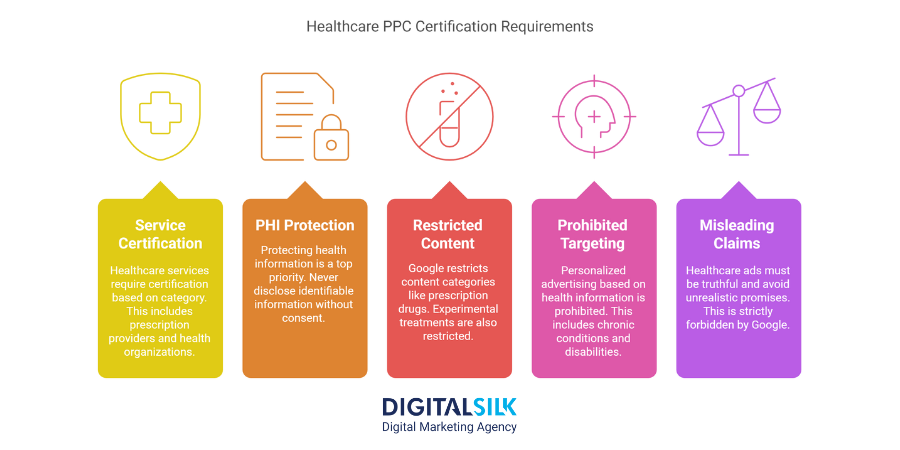
4. Use Dynamic And Responsive Ads
With 64.04% of global internet traffic coming from mobile devices, your medical practice needs advertising formats that adapt seamlessly across devices.
Dynamic and responsive ad formats offer powerful tools to automate creative optimization while expanding your reach to patients regardless of how they access information.
Dynamic Search Ads (DSAs) is an ad group type that automatically generates headlines and selects landing pages based on your website content.
These adaptive formats provide several key advantages:
- Fill keyword gaps by capturing relevant queries traditional campaigns may miss
- Save time by automating keyword and ad mapping
- Improve relevance with dynamically generated headlines to match search terms
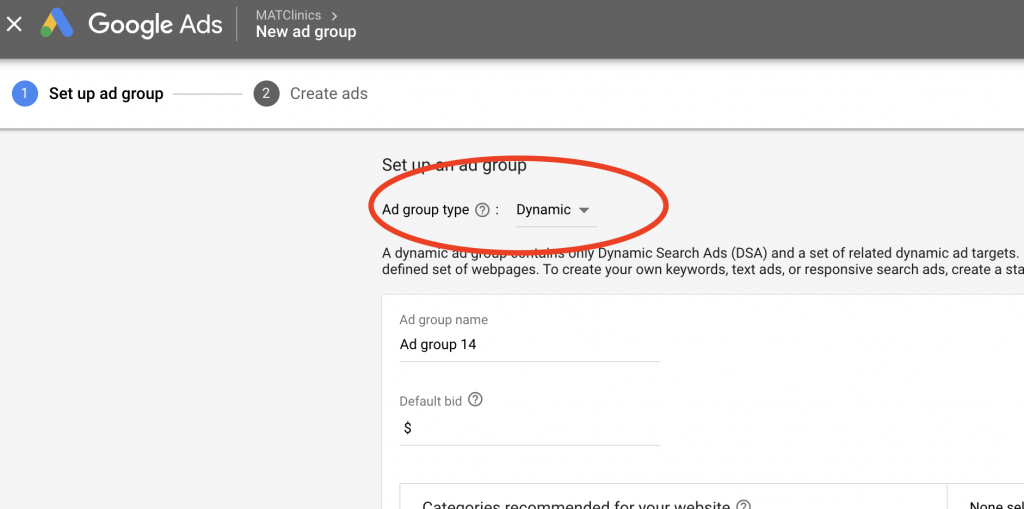
DSAs work best when your website has clear, well-structured service pages, since Google’s system pulls directly from your site to create ads.
Responsive Display Ads, on the other hand, are an ad format used within display campaigns.
They automatically adjust size, appearance and format to fit different placements across the Google Display Network.
You provide creative assets — images, logos, headlines, descriptions — and Google’s machine learning combines them for each ad slot to optimize performance across devices.
To maximize results for your healthcare paid search strategy with both strategies, you should:
- Prioritize strong, relevant service pages for DSAs
- Keep website content high-quality and keyword-rich
- Regularly monitor search terms reports to refine targeting
- Upload a variety of creative assets for Responsive Display Ads
- Prioritize mobile optimization
By incorporating these adaptive ad formats into your healthcare PPC strategy, you’ll expand your reach while simultaneously improving relevance — ultimately driving more qualified leads to your practice.
5. Enable Geo-Targeting For Local Reach
Most patients searching for healthcare providers want convenient access to care.
When someone needs a medical specialist, proximity matters — they typically prefer facilities near their home or workplace rather than traveling across town.
Geo-targeting lets your healthcare ads appear only in specific geographical locations where your ideal patients live and search.
This focused approach directs your advertising budget toward areas with the highest potential for patient conversion.
With the average cost per lead in the Health & Fitness industry reaching $61.56, narrowing your targeting ensures you allocate resources to appropriate locations and practices.
Google Ads location targeting enables your healthcare ads to appear only in geographic locations you select, which helps you focus on areas where potential patients are most likely to convert.
When setting up campaigns, choose locations that actually match where your patients come from, not just where your practice is physically located.
Additionally, ZIP code targeting works especially well for identifying responsive areas versus non-responsive ones.
You can monitor which ZIP codes generate the most valuable traffic and adjust your bidding strategy accordingly, testing different geographic areas and optimizing for those that perform best.
If your healthcare organization operates multiple facilities, your geo-targeting strategy needs additional refinement.
Each location deserves its own tailored campaign with:
- Location-specific keywords and ad copy
- Dedicated landing pages for each practice location
- Customized offers based on services available at each facility
Remember that geo-targeting for sensitive healthcare conditions requires user opt-in consent, with additional limitations for topics like reproductive health or addiction recovery.
This ensures your campaigns remain compliant while effectively reaching your local patient population.
6. Optimize Landing Pages For Conversions
In healthcare PPC, landing pages are not secondary assets, but direct drivers of booked appointments and revenue impact.
With the average healthcare PPC conversion rate at just 3%, any inefficiency in landing page design compounds quickly into lost acquisition opportunities.
Effective medical landing pages maintain a singular focus — every visual and written element should guide the visitor toward one specific action, whether that is booking a consultation, requesting a callback or scheduling a procedure.
Multiple competing messages dilute patient intent and weaken conversion rates.
Key principles for building landing pages that perform include:
- Clarity of purpose: Each page must be aligned to a single service or patient action, without unnecessary links or distractions.
- Speed and mobile-first design: 53% of users abandon websites that take more than 3 seconds to load, so you should prioritize optimized cross-device performance.
- Precision in messaging: Content should mirror the user’s search intent and ad messaging, maintaining tight continuity from click to page.
- Trust-building elements: Patient testimonials, certifications and published success outcomes should be integrated thoughtfully to reinforce credibility.
- Strategic calls-to-action: CTAs should be immediately visible, written in patient-centric language and supported by minimal, frictionless forms.
Your landing page should be viewed as a direct continuation of your ad with identical headlines, consistent offers and content that reflects the keywords that brought users there.
For diverse services, create separate landing pages for different keyword clusters.
7. Create Clear And Trustworthy Ad Copy
In a market where users are exposed to between 4,000 and 10,000 ads every day, healthcare organizations face an even steeper challenge — boosting visibility with messaging that is both credible and actionable.
For healthcare PPC strategies, ad copy must strike a balance between capturing attention and maintaining strict compliance with healthcare advertising regulations.
The PPC tips for healthcare companies to optimize ad copy include:
- Focus on clear patient value: Communicate outcomes that matter to patients — such as access to specialists, faster care
,or insurance acceptance — without using technical jargon. - Eliminate misleading or non-compliant language: Avoid unverified claims, overpromises or superlatives that could trigger regulatory scrutiny and erode patient trust.
- Embed E-E-A-T principles: Showcase clinical experience, professional credentials and transparent service offerings to build authority and credibility from the first interaction.
- Prioritize transparency: Set realistic expectations in your ads to foster early-stage trust and reduce post-click drop-off caused by perceived bait-and-switch tactics.
- Write for readability and speed: Use concise, patient-friendly language that delivers key information within the limited attention span most healthcare searchers allow.
Avoid using:
- Medical superlatives (e.g., “#1 treatment”)
- Guarantees (“Cure guaranteed”)
- Unverifiable claims
8. Use Ad Extensions To Maximize SERP Real Estate
Securing a dominant position on the search results page is non-negotiable when 54.4% of all clicks go to the top three Google listings.
Ad extensions — now known as Google Ad Assets — offer a strategic advantage by expanding your presence within those critical few spots, so it’s easier for patients to engage with your healthcare practice before even reaching your website.
Use the following paid search tips for doctors to use ad assets:
- Sitelinks: Add direct links to important pages like “Schedule an Appointment” or “Meet Our Doctors,” helping patients navigate to key actions immediately.
- Callouts: Include short, non-clickable highlights such as “Accepts All Major Insurance,” “Free Parking” or “Same-Day Appointments” to reinforce competitive advantages at a glance.
- Structured Snippets: Showcase specific services (e.g., “Cardiology, Pediatrics, Physical Therapy”) to help patients quickly qualify your practice.
- Call Assets: Display a clickable phone number directly within your ad, making it easy for patients to call and schedule without visiting your site.
- Location Assets: Show your nearest facility’s address and distance, connecting search intent with physical visits for practices where proximity matters.
Assets are not optional add-ons — they’re strategic levers to capture more clicks, reduce patient friction and push healthcare campaigns toward measurable growth.
| Asset Type | Primary Purpose | Patient Benefit | Strategic Value |
| Sitelink | Direct links to key pages | Faster navigation | Shortens path to conversion |
| Callout | Highlight service advantages | Quickly identify conveniences | Reinforces competitive strengths |
| Structured Snippet | Showcase offered services | Easier service qualification | Matches patients to services |
| Call Asset | Enable direct phone calls | Immediate contact option | Boosts appointment value |
| Location Asset | Display location proximity | Simplified facility access | Connects search to visits |
9. Conduct Regular PPC Audits
As digital advertising is projected to account for 73% of total global ad spending by 2028, healthcare organizations must treat PPC as a strategic investment, not just a lead-generation channel.
Sustained performance requires disciplined auditing, benchmarking against industry standards and smart integration with broader digital strategies.
Use Tools To Audit Campaigns Regularly
Consistent evaluation of Google Ads and Microsoft (Bing) Ads performance identifies where campaigns underperform or misallocate budget.
Automated tools such as Adalysis and TrueClicks help surface quality score issues, landing page weaknesses and budget misalignments.
Custom audits allow deeper analysis of service-line profitability, geographic performance and regulatory vulnerabilities specific to healthcare marketing.
Benchmark Against Healthcare-Specific Metrics
Industry benchmarks allow healthcare marketing teams to evaluate campaign performance based on meaningful standards, not just vanity metrics.
With 89% of U.S. healthcare marketers now using paid search advertising methods, competition for patient attention is high and it demands careful measurement and strategic adjustments.
Monitoring key metrics like click-through rates, cost-per-click trends and conversion metrics helps leadership set realistic performance goals and quickly spot opportunities for improvement.
Leverage PPC Data To Inform SEO Strategies
Your patients are already online. The question is whether they’re seeing your practice or your competitor’s.
PPC campaigns offer immediate insights into which keywords, messaging and page structures resonate with patients.
Healthcare organizations that analyze this data to inform SEO efforts can prioritize high-value content, sharpen service page strategies and validate messaging concepts before expanding organic investment.
Optimize Your PPC Strategy With Digital Silk
A strong PPC strategy helps medical service providers attract new patients efficiently and grow their practice with data-driven solutions.
At Digital Silk, we build custom PPC campaigns designed specifically for healthcare businesses, focusing on reaching the right audience, lowering acquisition costs and improving overall return on investment.
Our team combines thorough keyword research, ad copywriting tailored to patient needs and precise campaign management to drive more appointment bookings.
Digital Silk monitors performance closely, making data-driven adjustments to maximize your advertising spend and ensure your campaigns consistently deliver measurable results.
As a full-service web design agency, our services include:
- PPC services
- Healthcare marketing
- Digital marketing
- SEO services
- Branding and web design for healthcare providers
Ready to launch your healthcare paid search strategy?
Contact our team, call us at (800) 206-9413 or fill in the Request a Quote form below to schedule a consultation.
"*" indicates required fields


